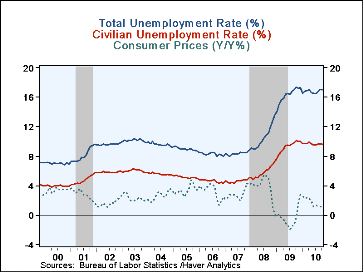 Global| Nov 29 2010
Global| Nov 29 2010U.S. Economic Misery Remains High, But Not Historic
by:Tom Moeller
|in:Economy in Brief
Summary
The "misery index" is a popular indicator of stress in the U.S. economy and it now shows plenty of it. The idea for the figure was created by Yale University economist Arthur Okun. The two components of the series are the unemployment [...]
 The "misery index" is a popular indicator of
stress in the U.S. economy and it now shows plenty of it. The idea for the
figure was created by Yale University economist Arthur
Okun. The two components of the series are the unemployment rate and the
year-to-year change in the Consumer Price Index. As typically measured, the
index's current level of 10.8 is up 5.1 percentage points from its 2006 low as
the rise in the unemployment rate to 9.6% has overwhelmed the slow rate of
consumer price inflation.
The "misery index" is a popular indicator of
stress in the U.S. economy and it now shows plenty of it. The idea for the
figure was created by Yale University economist Arthur
Okun. The two components of the series are the unemployment rate and the
year-to-year change in the Consumer Price Index. As typically measured, the
index's current level of 10.8 is up 5.1 percentage points from its 2006 low as
the rise in the unemployment rate to 9.6% has overwhelmed the slow rate of
consumer price inflation.
Another way to construct the index, however, would show more economic pain. The real index using the overall unemployment rate, which includes marginally attached and involuntarily part-time workers, also has doubled to 17.0% from its 2006 low. Many economists, as well as regular people, argue that economic distress by this measure is greater since it is due to lost employment. With higher prices for a product, the choice can be made to do without it or switch to something else, but a similar choice may not be available to those without a job.
Notable is the fact that for all this misery, times have been much worse during the postwar period. In 1980, the conventional index level reached a peak of 22.0 as higher oil prices drove inflation up and unemployment surged with two recessions. That index was more than double the level of the early-1970s. Shocking was the surge in the index from its early-1950s low of 3.0%.
The data in this report are available in Haver's USECON database.
| "Official" US Misery Index | Oct | Sep | Aug | July | 2009 | 2008 | 2007 |
|---|---|---|---|---|---|---|---|
| Total Index | 10.8 | 10.7 | 10.7 | 10.7 | 8.9 | 9.7 | 7.5 |
| Unemployment Rate (%) | 9.6 | 9.6 | 9.6 | 9.5 | 9.3 | 5.8 | 4.6 |
| Consumer Price Index (Y/Y %) | 1.2 | 1.1 | 1.1 | 1.2 | -0.4 | 3.8 | 2.9 |
| "Real" US Misery Index | |||||||
| Total Index | 18.2 | 18.2 | 17.8 | 17.8 | 15.9 | 14.4 | 11.2 |
| Overall Unemployment rate | 17.0 | 17.1 | 16.7 | 16.5 | 16.3 | 10.6 | 8.3 |
Tom Moeller
AuthorMore in Author Profile »Prior to joining Haver Analytics in 2000, Mr. Moeller worked as the Economist at Chancellor Capital Management from 1985 to 1999. There, he developed comprehensive economic forecasts and interpreted economic data for equity and fixed income portfolio managers. Also at Chancellor, Mr. Moeller worked as an equity analyst and was responsible for researching and rating companies in the economically sensitive automobile and housing industries for investment in Chancellor’s equity portfolio. Prior to joining Chancellor, Mr. Moeller was an Economist at Citibank from 1979 to 1984. He also analyzed pricing behavior in the metals industry for the Council on Wage and Price Stability in Washington, D.C. In 1999, Mr. Moeller received the award for most accurate forecast from the Forecasters' Club of New York. From 1990 to 1992 he was President of the New York Association for Business Economists. Mr. Moeller earned an M.B.A. in Finance from Fordham University, where he graduated in 1987. He holds a Bachelor of Arts in Economics from George Washington University.








